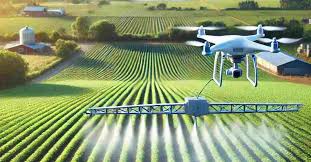Farming has always been a labor-intensive industry, and in recent years, technology has been playing an increasingly important role in making farming more efficient and sustainable. One of the most exciting innovations is the use of spraying drones.
These unmanned aerial vehicles are changing the way farmers manage chemicals, such as pesticides, herbicides, and fertilizers. Spraying drones not only help farmers apply these chemicals more effectively, but they also reduce waste, save time, and help protect the environment. But how exactly do these drones improve efficiency and reduce chemical use? Let’s explore.
What Are Spraying Drones?
Spraying drones are drones specifically designed to carry and distribute liquid chemicals, including pesticides and fertilizers, over crops. They come equipped with spray tanks, nozzles, and sensors that help control the amount of chemical applied to each part of the field.
Unlike traditional spraying methods, where chemicals are applied over large areas with no precision, drones allow farmers to target specific sections of a field. Here’s how they help:
- Spraying drones are especially useful for large farms, where it might be difficult or time-consuming to cover the entire area with traditional spraying methods.
- They can fly over fields, spray chemicals with precision, and even track changes in plant health, making them an indispensable tool for modern farming.
This targeted approach helps ensure that chemicals are used only where needed, minimizing unnecessary use and protecting the environment.
How Spraying Drones Improve Efficiency in Farming?
One of the best benefits of spraying drones is how they improve the overall efficiency of farming. Traditional methods of applying chemicals often involve large machinery or manual labor, both of which are time-consuming and labor-intensive. Spraying drones streamline this process by automating the application of chemicals, allowing farmers to cover vast areas of land quickly.
- Time-Saving: Spraying drones can cover large fields much faster than tractors or manual laborers. This means farmers can apply pesticides, herbicides, and fertilizers more quickly, leaving them with more time for other essential tasks.
- Labor Efficiency: With drones, farmers don’t need to rely on large teams of workers for spraying. Instead, they can operate the drones themselves, freeing up labor for other jobs on the farm. This reduces the need for additional staff, saving farmers on labor costs.
- Faster Turnaround: Drones allow farmers to apply chemicals in a fraction of the time it would take using traditional methods. This means that if a crop requires immediate treatment, farmers can respond much faster and prevent potential crop damage.
You can also explore AgFunderNews to keep up with the latest news on how drones are helping farming practices.
Reducing Chemical Use with Precision
The primary advantage of using spraying drones lies in their ability to apply chemicals with greater precision. Traditional methods often involve spraying chemicals over a large area, even if only parts of the field need treatment. This leads to unnecessary use of pesticides and fertilizers, wasting resources and increasing the environmental impact.
With drones, farmers can take a more targeted approach. Drones are equipped with sensors and cameras that can detect areas where pests, diseases, or nutrient deficiencies are present. Here’s how it helps:
- Targeted Application: Drones can identify and treat problem areas with high precision, ensuring that chemicals are only applied where necessary. This reduces the amount of chemicals used and prevents over-spraying, which can harm plants and the surrounding environment.
- Lower Environmental Impact: With more accurate spraying, fewer chemicals reach non-target areas, such as nearby water sources, soil, and vegetation. This helps reduce chemical runoff, which can cause long-term harm to the environment.
- Cost Savings: By reducing chemical use, drones also help farmers save money. With fewer pesticides and fertilizers needed, farmers can cut down on their overall input costs, making their operations more cost-effective in the long run.
The Environmental Benefits of Using Spraying Drones
Over-spraying and inefficient chemical application can lead to runoff, which contaminates nearby water sources and harms wildlife. The ability of drones to apply chemicals with precision helps mitigate these issues, leading to a cleaner and healthier environment.
- Reducing Runoff: Since drones can target specific areas of the field, they help ensure that excess chemicals do not run off into nearby water sources. This reduces the risk of pollution and protects ecosystems from harmful substances.
- Sustainable Farming Practices: Using drones to reduce chemical use is one step towards more sustainable farming. By minimizing the use of harmful chemicals, farmers can protect biodiversity, preserve soil health, and contribute to long-term environmental conservation.
- Less Impact on Non-Target Species: Traditional spraying methods often result in the unintended spraying of chemicals on plants, insects, or animals that are not the intended target. Drones help minimize this issue by applying chemicals only where they are needed.
Improving Crop Health with Drones
Spraying drones also play a significant role in improving the overall health of crops. By applying the right amount of nutrients and protection at the right time, drones help ensure that crops grow stronger and more resilient.
- Nutrient Management: Drones can deliver precise amounts of fertilizers to crops, helping them get the nutrients they need without over-application, which can harm the plants.
- Pest and Disease Control: With the ability to detect and target pest-infested areas, drones help reduce the risk of crop damage caused by pests or diseases. Early intervention ensures crops remain healthy and productive.
Conclusion
Spraying drones are transforming the agricultural industry by improving efficiency, reducing chemical use, and promoting sustainable farming practices. Their ability to target specific areas with precision allows farmers to save time, reduce costs, and minimize their environmental impact.
By adopting spraying drones, farmers can ensure that they are not only increasing their productivity but also contributing to the health of the planet. As drone technology continues to evolve, its role in agriculture will only grow, bringing more benefits to both farmers and the environment.
